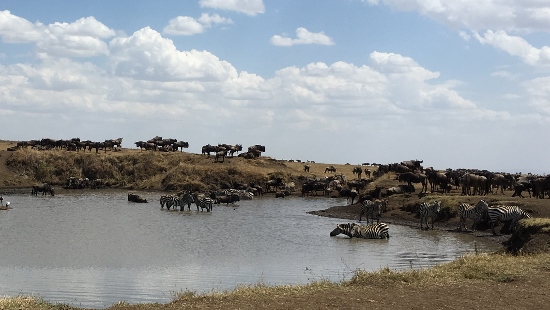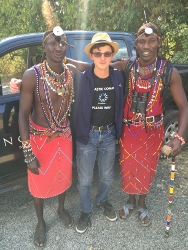Witnessing Kenya's Great Migration
By Jacob Kupchik

Photo by Jacob Kupchik
Recently, my family and I traveled to Kenya and stayed at Angama Mara, a safari lodge about an hour’s flight from Nairobi. The safari camp is perched on the Oloololo Escarpment overlooking the Great Rift Valley and the Maasai Mara. One of the highlights of our stay was our day-long safari into the Mara, and specifically, witnessing the great migration and the Mara River crossing.
What is the Great Migration and river crossing? Well, every year 1.5 million wildebeests, 300,000 zebras, and other animals migrate from Tanzania to Kenya in what’s known as the Great Migration. There are obstacles along the way for the animals, however, as predators anxiously lie in wait, and there are rivers the animals need to cross, (there are many crossings, at different times and at different locations, but they are still very rare.) I heard stories of people waiting for hours or even days, still not seeing a crossing, but I was lucky enough to see one after only an hour or so. After watching the animals pacing back and forth on the riverbank, deciding whether they wanted to cross the river, they finally took a leap of faith. It started with a brave few, and before we knew it, wildebeests and other animals were flooding into the water in large numbers. As several reached the other side of the river, others followed and entered the river. It seemed fairly easy for the animals, if not for the slew of crocodiles that were getting ready to strike.
The first kill was a zebra. The animals had stopped going into the river for a bit and the final few had yet to get out of the water. First a wildebeest made it across, then a zebra, leaving only one zebra left to go. It was then, however, that we could see a crocodile coming straight at it, and in an instant, it snapped at the zebra. The zebra struggled with the crocodile for a few moments, but to no avail. The crocodiles had their first kill.
There were still animals that hadn’t crossed yet, and the crossing started up again, and with more animals there were more opportunities for the now-alerted crocodiles. Lucky, there were only one or two more kills, and there was one zebra that even kicked one of the crocodiles that had tried to eat it. It still managed to get to the other side, and we later saw it with a gash on its thigh.
Overall, seeing the crossing was an amazing and educational experience. I feel very lucky to have been able to see it, and will cherish the memory of this experience. While I had a wonderful time, this may not be an experience for everyone—particularly the faint of heart, or those who might be sensitive to seeing animals being harmed or killed. Despite this, it was an opportunity to witness nature’s struggle for survival, and the cycle of life.
About Jacob Kupchik

Jacob Kupchik is an 8th grader at The Brandeis School, in Lawrence, NY on the South Shore of Long Island. He has been a traveler from a very young age, taking his first trip at 5 weeks old to visit his grandparents and great grandmother in Buenos Aires, Argentina. Since then he has traveled several times to Argentina and Uruguay as well as to Peru, Switzerland, France, Italy, Ireland, England, and Kenya, plus several states in the US.
He has a black belt in karate, plays the piano, and enjoys creating video games and documentaries and writing his own music. He is also a certified therapy dog handler with Pet Partners.
If you would like to suggest topics--or contribute a teen travel piece--e-mail us. |
|
|

